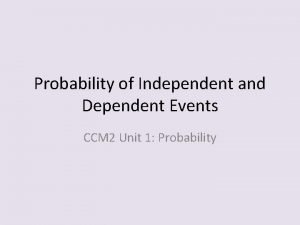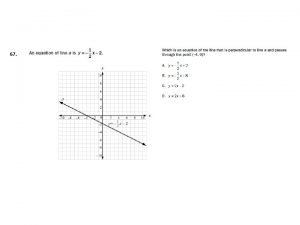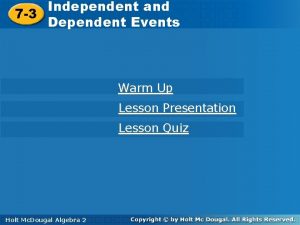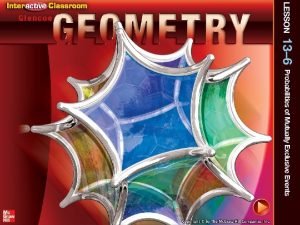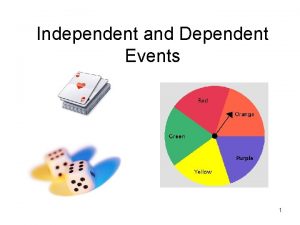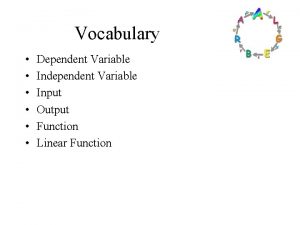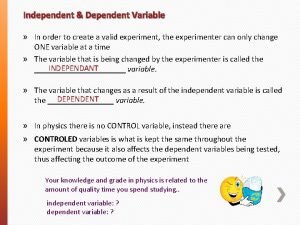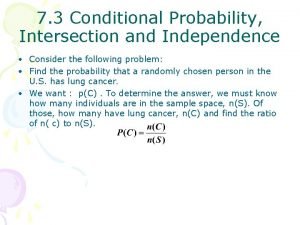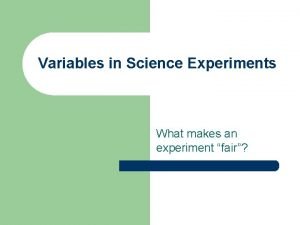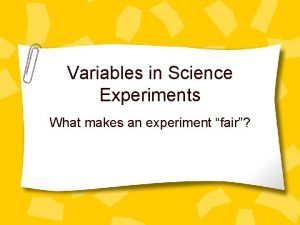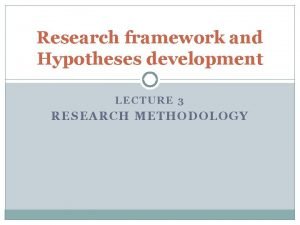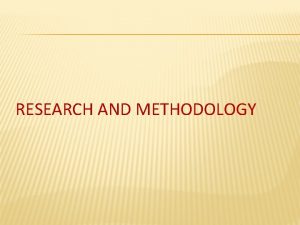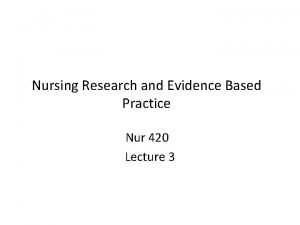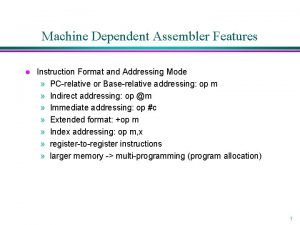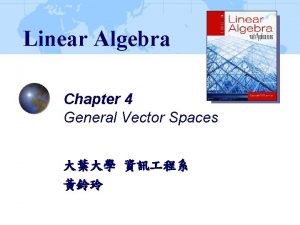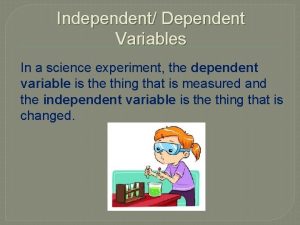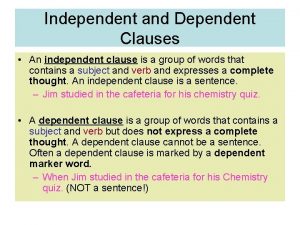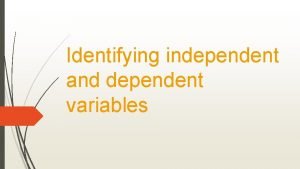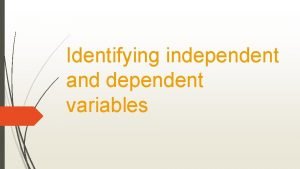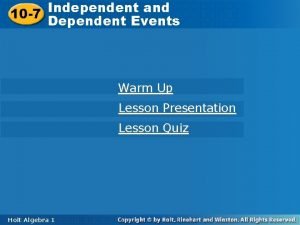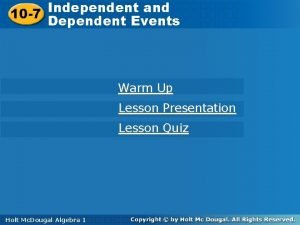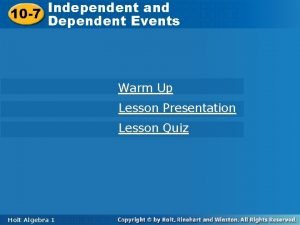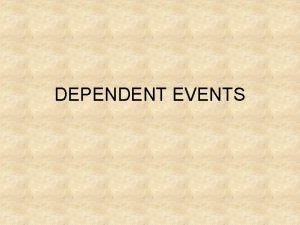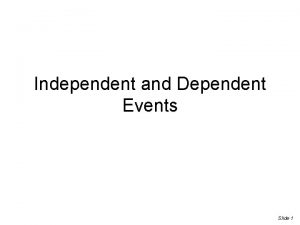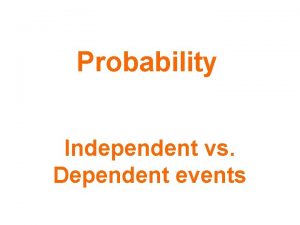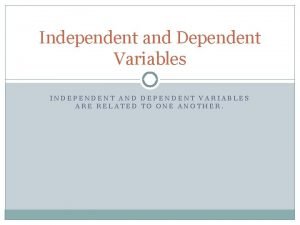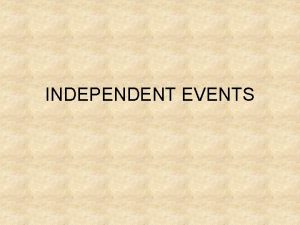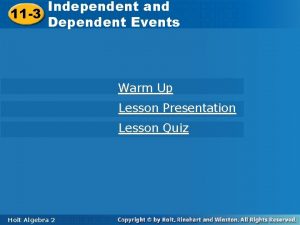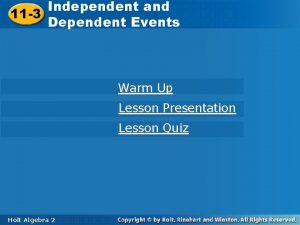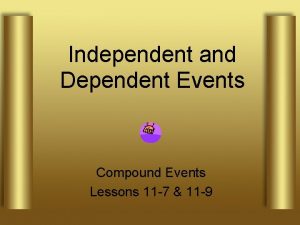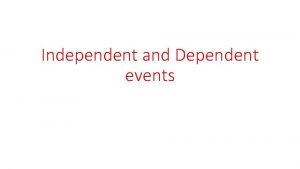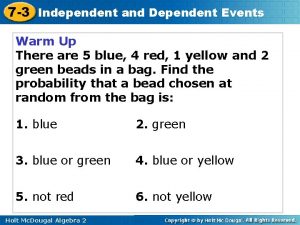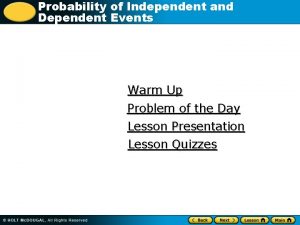Independent and 10 4 Dependent Events Warm Up






























- Slides: 30

Independent and 10 -4 Dependent Events Warm Up Problem of the Day Lesson Presentation Lesson Quizzes

Independent and 10 -4 Dependent Events Warm Up Multiply. Write each fraction in simplest form. 1. 2 3 5 5 6 25 2. 1 3 6 4 1 8 Write each fraction as a decimal. 2 3. 5 0. 4 32 4. 125 0. 256

Independent and 10 -4 Dependent Events Problem of the Day The area of a spinner is 75% red and 25% blue. However, the probability of its landing on red is only 50%. Sketch a spinner to show this can be. Possible answer: red blue

Independent and 10 -4 Dependent Events Learn to find the probabilities of independent and dependent events.

Independent and 10 -4 Dependent Events Vocabulary compound events independent events

Independent and 10 -4 Dependent Events A compound event is made up of two or more separate events. To find the probability of a compound event, you need to know if the events are independent or dependent. Events are independent events if the occurrence of one event does not affect the probability of the other. Events are dependent events if the occurrence of one does affect the probability of the other.

Independent and 10 -4 Dependent Events Additional Example 1: Classifying Events as Independent or Dependent Determine if the events are dependent or independent. A. getting tails on a coin toss and rolling a 6 on a number cube Tossing a coin does not affect rolling a number cube, so the two events are independent. B. getting 2 red gumballs out of a gumball machine After getting one red gumball out of a gumball machine, the chances for getting the second red gumball have changed, so the two events are dependent.

Independent and 10 -4 Dependent Events Check It Out: Example 1 Determine if the events are dependent or independent. A. rolling a 6 two times in a row with the same number cube The first roll of the number cube does not affect the second roll, so the events are independent. B. a computer randomly generating two of the same numbers in a row The first randomly generated number does not affect the second randomly generated number, so the two events are independent.

Independent and 10 -4 Dependent Events

Independent and 10 -4 Dependent Events Additional Example 2 A: Finding the Probability of Independent Events Three separate boxes each have one blue marble and one green marble. One marble is chosen from each box. What is the probability of choosing a blue marble from each box? The outcome of each choice does not affect the outcome of the other choices, so the choices are independent. 1 In each box, P(blue) =. 2 P(blue, blue) = 1 · 1 = 0. 125 Multiply. 2 2 2 8

Independent and 10 -4 Dependent Events Additional Example 2 B: Finding the Probability of Independent Events What is the probability of choosing a blue marble, then a green marble, and then a blue marble? 1 In each box, P(blue) =. 2 1 In each box, P(green) =. 2 P(blue, green, blue) = 1 2 · 1 1 = = 0. 125 Multiply. 2 8

Independent and 10 -4 Dependent Events Additional Example 2 C: Finding the Probability of Independent Events What is the probability of choosing at least one blue marble? Think: P(at least one blue) + P(not blue, not blue) = 1. 1 In each box, P(not blue) =. 2 P(not blue, not blue) = 1 1 Multiply. = = 0. 125 · · 2 2 2 8 Subtract from 1 to find the probability of choosing at least one blue marble. 1 – 0. 125 = 0. 875

Independent and 10 -4 Dependent Events Check It Out: Example 2 A Two boxes each contain 4 marbles: red, blue, green, and black. One marble is chosen from each box. What is the probability of choosing a blue marble from each box? The outcome of each choice does not affect the outcome of the other choices, so the choices are independent. 1 In each box, P(blue) =. 4 P(blue, blue) = 1 4 · 1 1 = = 0. 0625 4 16 Multiply.

Independent and 10 -4 Dependent Events Check It Out: Example 2 B Two boxes each contain 4 marbles: red, blue, green, and black. One marble is chosen from each box. What is the probability of choosing a blue marble and then a red marble? 1 In each box, P(blue) =. 4 1 In each box, P(red) =. 4 P(blue, red) = 1 4 · 1 1 = = 0. 0625 4 16 Multiply.

Independent and 10 -4 Dependent Events Check It Out: Example 2 C Two boxes each contain 4 marbles: red, blue, green, and black. One marble is chosen from each box. What is the probability of choosing at least one blue marble? Think: P(at least one blue) + P(not blue, not blue) = 1. 1 In each box, P(blue) =. 4 P(not blue, not blue) = 3 · 3 = 9 = 0. 5625 Multiply. 4 4 16 Subtract from 1 to find the probability of choosing at least one blue marble. 1 – 0. 5625 = 0. 4375

Independent and 10 -4 Dependent Events To calculate the probability of two dependent events occurring, do the following: 1. Calculate the probability of the first event. 2. Calculate the probability that the second event would occur if the first event had already occurred. 3. Multiply the probabilities.

Independent and 10 -4 Dependent Events Additional Example 3 A: Find the Probability of Dependent Events The letters in the word dependent are placed in a box. If two letters are chosen at random, what is the probability that they will both be consonants? Because the first letter is not replaced, the sample space is different for the second letter, so the events are dependent. Find the probability that the first letter chosen is a consonant. P(first consonant) = 6 = 2 9 3

Independent and 10 -4 Dependent Events Additional Example 3 A Continued If the first letter chosen was a consonant, now there would be 5 consonants and a total of 8 letters left in the box. Find the probability that the second letter chosen is a consonant. P(second consonant) = 5 8 5 2 · 5 = 12 3 8 Multiply. The probability of choosing two letters that are both consonants is 5. 12

Independent and 10 -4 Dependent Events Additional Example 3 B: Find the Probability of Dependent Events If two letters are chosen at random, what is the probability that they will both be consonants or both be vowels? There are two possibilities: 2 consonants or 2 vowels. The probability of 2 consonants was calculated in Example 3 A. Now find the probability of getting 2 vowels. Find the probability that P(first vowel) = 3 = 1 the first letter chosen is a 9 3 vowel. If the first letter chosen was a vowel, there are now only 2 vowels and 8 total letters left in the box.

Independent and 10 -4 Dependent Events Additional Example 3 B Continued 1 P(second vowel) = 2 = 4 8 Find the probability that the second letter chosen is a vowel. 1 1 · 1 = Multiply. 12 3 4 The events of both consonants and both vowels are mutually exclusive, so you can add their probabilities. 5 1 = 6 = 1 + 2 12 12 12 P(consonant) + P(vowel) The probability of getting two letters that are either both consonants or both vowels is 1. 2

Independent and 10 -4 Dependent Events Remember! Two mutually exclusive events cannot both happen at the same time.

Independent and 10 -4 Dependent Events Check It Out: Example 3 A The letters in the phrase I Love Math are placed in a box. If two letters are chosen at random, what is the probability that they will both be consonants? Because the first letter is not replaced, the sample space is different for the second letter, so the events are dependant. Find the probability that the first letter chosen is a consonant. P(first consonant) = 5 9

Independent and 10 -4 Dependent Events Check It Out: Example 3 A Continued If the first letter chosen was a consonant, now there would be 4 consonants and a total of 8 letters left in the box. Find the probability that the second letter chosen is a consonant. P(second consonant) = 5 5 · 1 = 18 9 2 4 = 1 8 2 Multiply. The probability of choosing two letters that are both consonants is 5. 18

Independent and 10 -4 Dependent Events Check It Out: Example 3 B If two letters are chosen at random, what is the probability that they will both be consonants or both be vowels? There are two possibilities: 2 consonants or 2 vowels. The probability of 2 consonants was calculated in part 3 A. Now find the probability of getting 2 vowels. Find the probability that 4 P(first vowel) = the first letter chosen is a 9 vowel. If the first letter chosen was a vowel, there are now only 3 vowels and 8 total letters left in the box.

Independent and 10 -4 Dependent Events Check It Out: Example 3 B Continued P(second vowel) = 3 8 Find the probability that the second letter chosen is a vowel. 12 = 1 4 · 3 = Multiply. 72 9 8 6 The events of both consonants and both vowels are mutually exclusive, so you can add their probabilities. 5 + 18 1 = 8 = 4 9 18 6 P(consonant) + P(vowel) The probability of getting two letters that are either both consonants or both vowels is 4. 9

Independent and 10 -4 Dependent Events Lesson Quizzes Standard Lesson Quiz for Student Response Systems

Independent and 10 -4 Dependent Events Lesson Quiz Determine if each event is dependent or independent. 1. drawing a red ball from a bucket and then drawing a green ball without replacing the first dependent 2. spinning a 7 on a spinner three times in a row independent 3. A bucket contains 5 yellow and 7 red balls. If 2 balls are selected randomly without replacement, what is the probability that they will both be yellow? 5 33

Independent and 10 -4 Dependent Events Lesson Quiz for Student Response Systems 1. Identify the dependent event. A. drawing an apple from a basket and then drawing an orange without replacing the apple B. drawing an apple from a basket and then drawing an orange after replacing the apple C. getting a 3 and then a 2 when a fair number cube is rolled twice D. spinning an even number on a spinner two times in a row

Independent and 10 -4 Dependent Events Lesson Quiz for Student Response Systems 2. Identify the independent event. A. pulling out a white sock and then a blue sock from a dresser B. choosing a student from 7 th Grade and a student from 8 th Grade C. drawing a six and then a diamond from a deck of well shuffled cards D. choosing three members from a club

Independent and 10 -4 Dependent Events Lesson Quiz for Student Response Systems 3. The letters in the word PROBABILITY are placed in a box. If two cards are chosen at random, what is the probability that they will both have the letter B? A. B. C. D.
 Identify independent and dependent events
Identify independent and dependent events Independent events statistics
Independent events statistics 7-3 independent and dependent events answers
7-3 independent and dependent events answers 10-7 independent and dependent events
10-7 independent and dependent events How to tell if two events are independent
How to tell if two events are independent 13-5 probabilities of independent and dependent events
13-5 probabilities of independent and dependent events Independent and dependent probability
Independent and dependent probability Dependent variable, y value, output
Dependent variable, y value, output Independent vs dependent graph
Independent vs dependent graph Discrete statistics
Discrete statistics Conditional probability intersection
Conditional probability intersection What is independent variable in science
What is independent variable in science Experimental design independent and dependent variables
Experimental design independent and dependent variables Independent variable and dependent variable in research
Independent variable and dependent variable in research Meaning of research design
Meaning of research design Leucoplast double membrane
Leucoplast double membrane Time frame example
Time frame example Explain machine independent loader features
Explain machine independent loader features Assembler is a machine dependent, because of?
Assembler is a machine dependent, because of? Span of a vector
Span of a vector Dependent demand vs independent demand
Dependent demand vs independent demand Dependent and independent inventory
Dependent and independent inventory How to determine the independent variable
How to determine the independent variable Four types of clauses
Four types of clauses What are dependent and independent variables
What are dependent and independent variables Dependent clauses
Dependent clauses Independent clause dependent clause
Independent clause dependent clause Difference between dependent and independent variable
Difference between dependent and independent variable Independent vs dependent variable
Independent vs dependent variable Independent variable and dependent variable
Independent variable and dependent variable What is a constant variable in science
What is a constant variable in science
